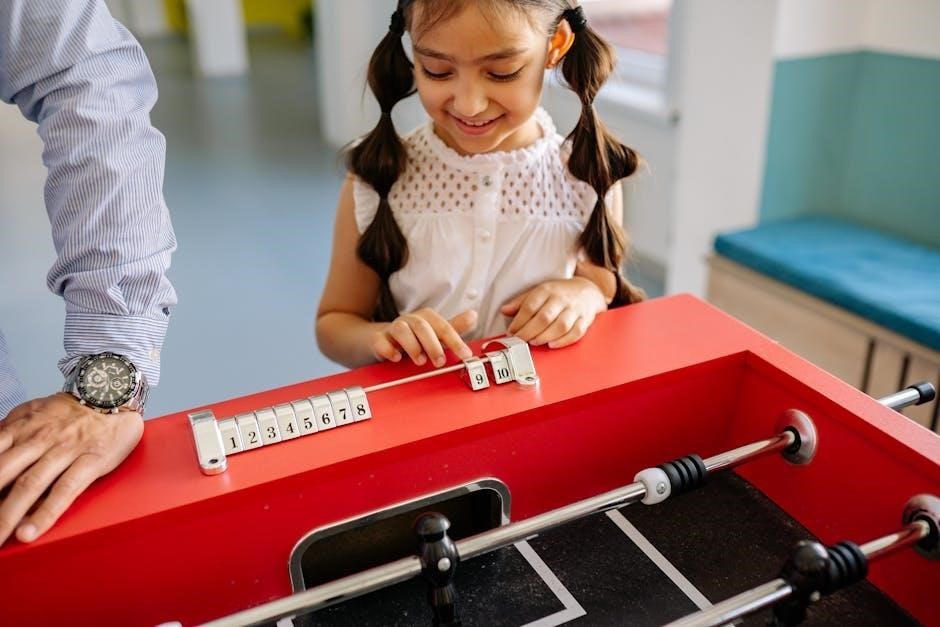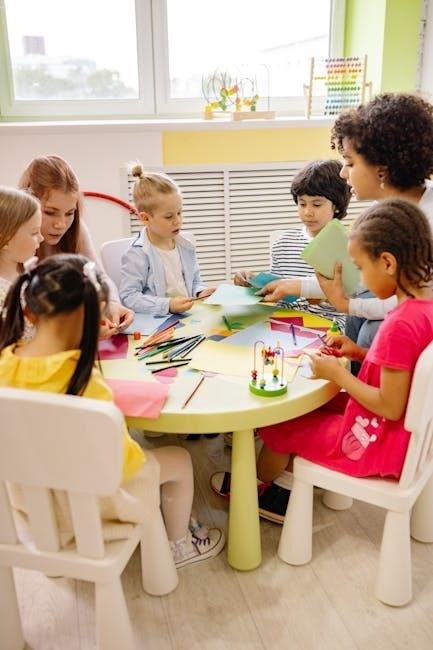Manual teacher is an educational professional specializing in imparting practical skills through vocational education, using
various methods
to foster technical competencies and craftsmanship, often incorporating hands-on learning experiences effectively always.
Job Overview of Manual Teacher
A manual teacher is responsible for delivering practical and theoretical instruction in various manual skills, creating lesson plans and demonstrating techniques to ensure student understanding.
The role involves fostering technical competencies and craftsmanship, often incorporating hands-on learning experiences, and ensuring the safety of all students during practical activities.
A manual teacher plays a vital role in shaping students’ skills and knowledge, providing them with the necessary tools to succeed in their chosen vocational field.
The job requires a deep understanding of the subject matter, as well as the ability to communicate complex ideas in a clear and concise manner.
Effective manual teachers are able to adapt their teaching methods to meet the needs of their students, providing individualized support and guidance where necessary.
By providing high-quality instruction and guidance, manual teachers can help students achieve their full potential and go on to succeed in their chosen careers.
Responsibilities of a Manual Teacher
A manual teacher has a range of responsibilities, including planning and delivering lessons, assessing student progress, and maintaining a safe and well-organized learning environment.
They must also demonstrate techniques and guide students as they practice and apply their new skills, providing feedback and support where needed.
In addition to teaching, manual teachers are often responsible for managing resources, including equipment and materials, and ensuring that they are used safely and efficiently.
They may also be involved in curriculum development, working with other teachers and educators to design and implement new courses and programs.
Effective communication is also a key responsibility of a manual teacher, as they must be able to clearly explain complex concepts and provide constructive feedback to students.
By fulfilling these responsibilities, manual teachers can help students achieve their goals and develop the skills and knowledge they need to succeed in their chosen careers, with a focus on practical skills.

Role of a Manual Teacher in Education
Manual teachers play a vital role in education, fostering technical skills and craftsmanship through hands-on learning experiences and activities always effectively.
Importance of Manual Skills in Education
Manual skills are essential in education as they provide students with hands-on experience and practical knowledge. The incorporation of manual skills in education helps to foster technical competencies and craftsmanship, which are vital for students’ future careers. Through manual skills, students develop problem-solving skills, critical thinking, and creativity, which are highly valued in the workforce. Additionally, manual skills education helps students to develop a sense of responsibility and self-reliance, as they learn to work independently and complete tasks. The importance of manual skills in education cannot be overstated, as it provides students with a well-rounded education and prepares them for an ever-changing world. By including manual skills in education, schools can help students develop into capable and confident individuals, equipped with the skills and knowledge necessary to succeed in their chosen careers and make a positive contribution to society. Manual skills are a crucial part of a comprehensive education.
Types of Manual Skills Taught by a Manual Teacher
A manual teacher instructs students in various manual skills, including woodworking, metalworking, and technical drawing. These skills are taught through hands-on learning experiences, allowing students to develop their technical competencies and craftsmanship. Other types of manual skills taught by a manual teacher may include crafts, electronics, and mechanics. The specific skills taught can vary depending on the school and the teacher’s area of expertise. Manual teachers may also provide instruction in areas such as tool safety, measurement, and materials science. By teaching these manual skills, manual teachers help students develop a range of skills that are valuable in many different careers and areas of life. The skills taught by a manual teacher are practical and relevant, and can help students develop into capable and confident individuals. Manual skills are an essential part of a well-rounded education, and manual teachers play a crucial role in providing this instruction to students.

Qualities of a Good Manual Teacher
A good manual teacher possesses patience, organizational skills, and ability to demonstrate techniques clearly and effectively always.
Effective Instruction Methods for Manual Teachers
Manual teachers use various methods to deliver instruction, including demonstrations, hands-on activities, and project-based learning. These methods help students develop practical skills and apply theoretical knowledge in real-world contexts. Effective manual teachers also use assessment tools to evaluate student progress and provide feedback. They create a supportive learning environment that encourages students to ask questions and explore their creativity. By using a combination of instructional methods, manual teachers can cater to different learning styles and abilities, ensuring that all students have the opportunity to succeed. Additionally, manual teachers can use technology to enhance instruction, such as videos and simulations, to make learning more engaging and interactive. Overall, effective instruction methods are essential for manual teachers to help students develop the skills and knowledge they need to succeed in their chosen careers. Manual teachers play a crucial role in shaping the next generation of skilled workers.
Creating a Positive Learning Environment
Manual teachers strive to create a positive learning environment that fosters student engagement and motivation. This is achieved by establishing clear expectations and rules, promoting respect and inclusivity, and encouraging open communication. A well-organized and safe workspace is also essential, with adequate equipment and resources to support practical activities. Manual teachers should be approachable and supportive, providing individualized attention and feedback to help students build confidence and self-esteem. By promoting a sense of community and teamwork, manual teachers can help students develop essential life skills, such as collaboration and problem-solving. A positive learning environment is critical for students to feel comfortable taking risks and exploring their creativity, which is essential for learning and skill development. Effective classroom management and a supportive atmosphere are key to creating a positive learning environment that benefits all students. This environment helps students to stay focused and motivated throughout the learning process.

Teaching Manual and Resources
Manual teachers utilize various resources, including textbooks and online materials, to support instruction and student learning effectively always with available tools and equipment in the classroom setting daily.
Understanding the Teaching Manual Model
The teaching manual model is a comprehensive guide for manual teachers, providing them with the necessary tools and resources to deliver effective instruction. This model is designed to support the development of practical skills, fostering technical competencies and craftsmanship in students. By understanding the teaching manual model, manual teachers can create a structured learning environment that promotes hands-on learning experiences. The model includes a range of activities and assessments that can be used to evaluate student progress and understanding. Additionally, the teaching manual model provides guidance on how to create a safe and inclusive learning environment, which is essential for students to feel comfortable and confident in their abilities. Overall, the teaching manual model is an essential resource for manual teachers, supporting them in their role and helping to ensure that students receive a high-quality education. The model is also flexible, allowing teachers to adapt it to meet the needs of their students.
Practical Guide for Inclusive Education
A practical guide for inclusive education is essential for manual teachers to create a learning environment that caters to the diverse needs of their students. This guide provides teachers with a range of strategies and techniques to support students with different abilities and learning styles. The guide includes activities and resources that can be used to promote inclusivity and diversity in the classroom. By using this guide, manual teachers can ensure that all students feel valued and supported, and that they have equal access to learning opportunities. The guide also provides information on how to adapt teaching methods to meet the needs of students with disabilities. Overall, a practical guide for inclusive education is a valuable resource for manual teachers, helping them to create a positive and inclusive learning environment that supports the needs of all students. The guide is easy to use and implement in the classroom.

